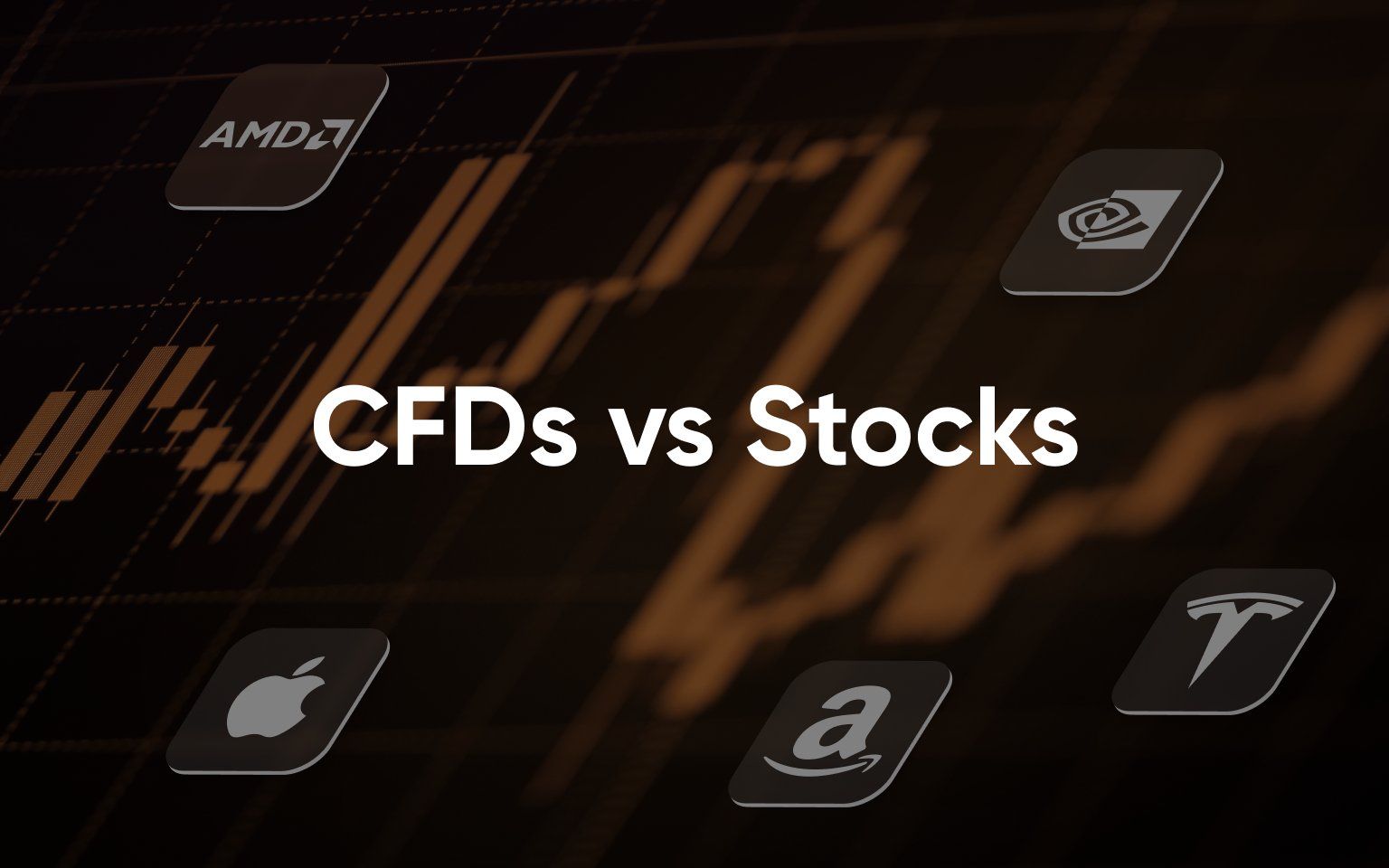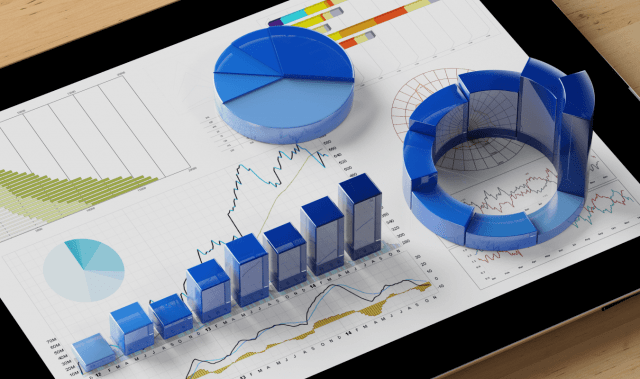CFDs vs stocks: What should traders know?

How does trading CFDs compare with stock trading? Below, we’ll look into the essential similarities and differences to know between these key trading terms, from leverage to asset class information and more.
CFDs and stocks: how do they compare?
CFDs (contracts for difference) and stocks (shares) trading are often compared, but they’re quite different as concepts. CFDs are instruments that offer access to various markets, including forex, commodities, and indices, while stocks are focused solely on the performance of listed companies through shares trading.
When you trade share CFDs with us, you can access global stocks alongside other asset classes – all with the flexibility and leverage that CFDs provide. However, it’s important to remember that leverage amplifies losses as well as profits.
To clarify the distinctions between CFD and stock trading, here’s the definition of each term.
What are CFDs?
CFDs are derivatives that let you trade on price movements across various assets – like stocks, commodities, or forex – without owning them. They’re flexible, with no fixed end date, so you can keep your position open as long as you like. CFDs are popular for short to medium-term trading and allow leverage (also known as margin trading). This means you can control a larger position with a smaller outlay, though this also increases potential losses as well as profits.
With CFDs, you have the choice of taking a position on an asset rising in price, known as a long position, or falling in price, known as a short position. Bear in mind that the below illustrations only shows the potential profit – if the price were to go in the opposite direction in each scenario, you would instead incur a loss.
Learn more about CFD trading and how it works.

What are stocks?
Stocks represent ownership in a company and are divided into individual units called shares. When a company goes public, it often raises money by issuing shares to investors, which can then be bought and sold on stock exchanges like the New York Stock Exchange or London Stock Exchange.
Companies first issue shares in the primary market through initial public offerings (IPOs), where investors buy them directly. Once listed, shares trade in the secondary market, where their prices fluctuate based on supply and demand. You can take positions on stocks in two ways:
- Investing in stocks means purchasing these shares outright, with the aim of benefiting from price appreciation and, in some cases, dividends.
- Trading stocks as derivatives such as CFDs is how you’ll trade them on our platform. Below, you’ll see a range of share CFDs to choose from in our market search.
Learn more about shares trading and how it works.
Why do traders choose CFDs?
Here’s an overview of why you might choose to trade CFDs.
-
Broad market access: trade shares, commodities, forex, and more from a single platform.
Leverage (also known as margin trading): control larger positions with a smaller initial outlay, enhancing potential returns and risks.
Flexible duration: no fixed expiration dates, allowing traders to close positions when desired.
Diversification: easily diversify across different asset classes within one account.
Short- and medium-term focus: may suit day trading, where people look to respond to immediate market conditions.
Why do traders choose stocks?
Here’s an overview of why you might choose to trade stocks.
-
High liquidity: stock markets see significant trading volume, making it easier to enter and exit positions efficiently.
Market hours aligned with exchanges: trading occurs during stock exchange hours, with some markets offering extended or after-hours trading.
Leverage: with CFDs, traders can control larger positions with a smaller investment, amplifying both potential gains and risks.
Exposure to individual companies: trade based on company performance, earnings reports, and industry trends.
Diverse opportunities: access to a wide range of sectors, from technology to healthcare, allowing traders to capitalise on different market conditions.
Here’s more on the comparison between stocks and CFDs.

How are stocks traded with CFDs?
When trading stocks via CFDs, traders speculate on a stock’s price movements without owning the underlying shares. A share CFD mirrors the price changes of the stock listed on an exchange, allowing traders to profit from rising or falling prices by going long or short.
With CFD share trading, traders can use leverage, which means they only need to put down a portion of the full trade value. This allows for potentially greater exposure, though it also amplifies both gains and losses. Additionally, share CFDs provide the flexibility to go long (if expecting a stock to appreciate) or short (if anticipating a depreciation).
Additionally, share CFDs provide flexibility in position sizing and do not have fixed contract expirations, unlike some traditional stock derivatives. Traders can also benefit from features like extended trading hours on select stocks and the ability to react to market events without the restrictions of direct share ownership.
Which is better out of CFDs vs stocks?
For derivative traders, whether CFDs or stocks is better depends on individual trading goals and market preferences. CFDs offer broad market access, covering various asset types like commodities, indices, and shares, allowing for diversification within a single account. This flexibility can benefit traders looking to speculate across multiple markets, each with unique drivers and opportunities.
Stock trading, on the other hand, is focused solely on taking a position on company shares. Traditional share investing involves ownership, which comes with additional factors such as corporate actions (e.g., dividends and voting rights). While share trading is typically limited to stock exchange hours, some markets offer extended trading sessions.
Remember though that stocks can be traded as CFDs, allowing traders to speculate on share price movements without owning the stock themselves. This is often done using the same fundamental and technical analysis approach.
In short, CFDs are ideal for traders who value market variety and flexibility, while shares may be better for those who prefer a focused market centred on stock movements. Each has unique advantages (and drawbacks), so the choice largely depends on the trader’s strategy and preferred assets.
Trading CFDs and stocks with us
When you trade CFDs and stocks with us, you can speculate long or short on the price of a wide range of markets. To prepare, read up on the trading essentials, and inform your positions with the latest trading news and analysis from our expert analysts. Also, it’s advisable to ensure your risk management strategy is good enough to prepare you for potential volatility, and learn about how to improve your trading psychology to maximise your confidence in the markets.
Need more support? Try our step-by-step stock course to guide you through the basics to the advanced concepts.
FAQs
Is stock trading CFD trading?
Not exactly. Stock trading and CFD trading are both types of derivative trading, but they’re not the same. While stocks can be traded as CFDs, shares trading is focused on the trading of stocks alone, while general CFD trading allows speculation on a wider range of assets, including forex pairs, currencies and indices.
What is a CFD in stock trading?
A CFD (contract for difference) in stock trading allows you to trade without owning the underlying shares. It’s a contract between you and the broker to exchange the difference in the stock's price from when you open the trade to when you close it. This lets you go long or short on shares and trade with leverage.
Can you trade shares without CFDs?
Yes, you can trade shares directly without using CFDs or derivatives, although it’s more commonly referred to as investing. This most often involves buying shares via a stockbroker or investing platform with the intention of profiting from price rises. Many brokers offer direct share dealing accounts specifically for this purpose, which may have different costs and features compared to CFD trading.
Find out more about CFD and share trading

What is CFD trading?
